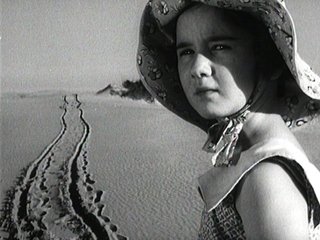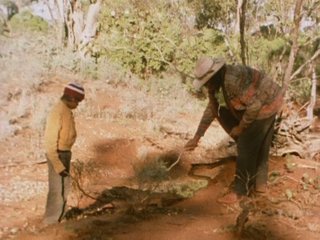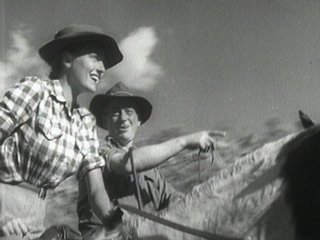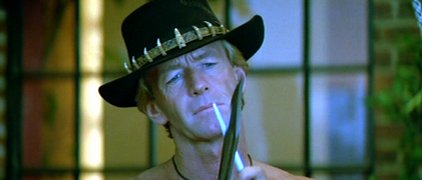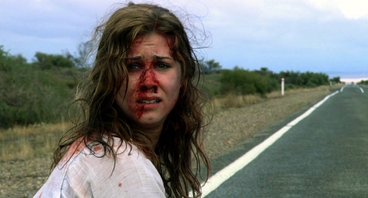Outback on Screen
This essay has also been published by the Cinematheque Quarterly of the National Museum of Singapore, at which Graham lectured on The Outback on Screen on 9 August 2011.
The camera, as if fixed at the top of a windmill, pans 360 degrees around a limitless desert, interrupted only by a railway line and a tiny schoolhouse at the start of Wake in Fright (Ted Kotcheff, 1971). Two small girls in sunbonnets drag a billycart across isolated sand dunes in The Back of Beyond (John Heyer, 1954), not realising they have crossed their own tracks from hours before. An Aboriginal man explains the significance of rock art in Walya Ngamardiki: The Land My Mother (David Roberts, 1976); and a young Aboriginal fugitive from the law journeys along an outback road while learning something of himself in Beneath Clouds (Ivan Sen, 2002). All of these films draw their considerable power from the Australian outback – on screen, as in life, a place for endless dreaming, living and working; of unnameable fears, of romance and getting lost.
Many of Australia’s creative interpretations of the outback over the last two centuries have reflected a mostly immigrant people’s interpretation of a landscape very different to the lands which they or their forbears came from. But like artists, poets and novelists, Australian filmmakers from the beginning have used the outback to define a sense of belonging. Covering 70 per cent of Australia, the outback is remote, arid and lightly populated. Most of the remaining continent has been defined as ‘the bush’, comprising the well-watered domesticated or semi-domesticated coastal fringes east and south of the Great Dividing Range flanking eastern Australia, moving west via Melbourne to Adelaide as well as incorporating the island of Tasmania. Today, when most of Australia’s almost 23 million people live in urban areas, the character of the bush survives as a major ingredient in the nation’s novels, poetry, paintings, feature and short films, TV drama and advertising.
In 1896 cinema made its first global appearance at a time of intense nationalism for Australian identity, especially as interpreted through literature and painting. Australian novelists, short story writers and ballad writers of the 1880s and 1890s used the bush and outback to define what it was to be Australian. The painters Tom Roberts, Frederick McCubbin and Arthur Streeton created their own myths about the bush’s frontier and farm life. From the 1890s onward Australian cinema would perpetuate these myths, eventually questioning and extending them.
The first Australians
Prior to white settlement, Aboriginal people had occupied Australia for at least 50,000 years – not a single Aboriginal nation but a gathering of several hundred communities or tribes, each with its own language, set of spiritual beliefs and territory on which many lived a nomadic and spiritual existence that recognised a community’s unique relationship with the land. Whites occupied much of that land after European settlement in 1788, dispossessing most tribes except those living a very remote existence.
Aboriginal people were first officially recognised as Australian citizens in 1967, one year after the Northern Territory Gurindji tribe launched the first Indigenous bid to obtain title to traditional land. They were among the earliest Australians filmed in the 1890s. In 1898 Cambridge University anthropologist Alfred Cord Haddon filmed Torres Strait islanders and mainland Aborigines, making this the world’s first film of an anthropological field trip (see Torres Strait Islanders, 1898). In 1901 and 1912 Professor Walter Baldwin Spencer filmed the lifestyles and spiritual activities of the tribes of Central and Northern Australia. Aborigines on screen in early filmmaking were often exploited subjects rather than people who had any say in how they were filmed and who would see the results. With rare exceptions, it was not until the 1960s and ’70s that documentary filmmakers sought to include the perspective of Aboriginal people. David Roberts in 1976 made the documentary Walya Ngamardiki: The Land My Mother, featuring Arnhem Land Aboriginal people talking about traditional attachment to their land and their attitudes to the uranium mining that could change it irretrievably. Oliver Howes’s documentary On Sacred Ground (1981) looks at the dispossession and loss of identity that provides a background to the late 1970s Noonkanbah land rights confrontation between traditional Aboriginal owners and miners in the Kimberley region of Western Australia.
Over time, Aboriginal people gained opportunities to speak for themselves about their relationship to and ownership of land, a number of whose landforms had sacred associations. More recently a new generation of Aboriginal filmmakers producing for a variety of screen media, including television, have been telling stories of Aboriginal history, myths, legends and connections with the land. Many notable titles include My Survival as an Aboriginal (Essie Coffey, 1978), Willigan’s Fitzroy (Warwick Thornton, 2000), Narbalek (Beck Cole, 2000), Queen of Hearts (Danielle Maclean, 2003), Mparntwe Sacred Sites (Danielle Maclean, 2004), Plains Empty (Beck Cole, 2005), and the seven-part historical series First Australians (Rachel Perkins, 2008).
Taming the landscape
Australia’s much earlier white filmmakers of outback films had stressed the need to tame what Europeans saw as a wild and alien landscape, to fill it with Anglo-Irish farmers who would pack it with herds of sheep and endless fields of wheat. The Squatter’s Daughter (Ken G Hall, 1933) begins with a celebratory montage of thousands of sheep swarming across the Australian landscape as if to dominate and claim it forever. The Pioneers (versions of 1916 and 1925) and Charles Chauvel’s Heritage (1935) and Sons of Matthew (1949) stretch depictions of land-taming across several generations. Aboriginal people, when they appeared in pre-1950 pioneering films, were usually depicted as attackers rather than defenders of their land. This changed with the Ealing Studios film Bitter Springs (Ralph Smart, 1950), a compassionate look at Aboriginal dispossession. The theme was to continue in Australian narrative films and documentaries, with Rachel Perkins’ short feature One Night the Moon (2001) looking not only at displacement but the need for reconciliation between black traditional owners and white settlers.
Screen portrayals of the white men and women who worked on outback land have inevitably ranged from a straightforward rendering of the work of pioneers and cattle drovers through to films that have looked at outback characters with a more analytical eye. At the height of the 1930s economic depression, the main enemies of the farming family in On Our Selection (Ken G Hall, 1932) are drought and a creditor from the city. In The Overlanders (Harry Watt, 1946) the adversary is a never-seen Second World War enemy, the Japanese, who might or might not launch an all-out invasion of Australia after periodically bombing Darwin. In both cases the hero is an Australian archetype. In Selection it is the stout and bearded family patriarch Dad Rudd (Bert Bailey), a first-generation pioneer, a bit of a buffoon who nevertheless represented the idealised Australia of the 1880s and ’90s. The younger hero of The Overlanders (1946), skinny and clean-shaven, is stockman Dan McAlpine (Chips Rafferty), a modern pragmatist who might have had no time for Dad Rudd’s wistful yarn-spinning.
The outback types that Chips Rafferty essayed in The Overlanders (1946), Bitter Springs (1950) and The Phantom Stockman (Lee Robinson, 1953) are distinctive Australian ‘doers’, fair and democratic, sometimes loners. Rafferty’s final big-screen role, a country town policeman in Wake in Fright (1971), shows a character both sinister and genial, indicating that Australian cinema’s view of outback character was drifting into darker places. In Wake in Fright it is Rafferty who introduces a holidaying schoolteacher John Grant (Gary Bond) to the temptations of an isolated town’s gambling and binge drinking, leading to events that unbalance and threaten Grant’s life.
One of the support cast in Wake in Fright (1971) is Jack Thompson, who four years later starred as Foley, the sheep-shearing hero of Sunday Too Far Away (1975). Foley is one of a team of men grappling with rural isolation, unfair work practices, within-the-team competition and the death of one of their mates from alcoholism. As it had been in Wake in Fright, the desert around them is drearily oppressive, giving little sign of the shearers’ connectedness to a life elsewhere. What sustains Sunday is the shearing team’s humour and camaraderie, and the film shrewdly blends the appeal of older outback films with more universal themes that helped ensure its international critical acclaim.
For the most part, outback women on screen have been shown to be either strongly self-reliant or somewhat reliant on the men who worked with or supported them. There have been two film versions of the stage play The Squatter’s Daughter (1910 and 1933), both with a woman sheep station manager in conflict with unpleasant males on rival properties. The heroine of A Girl of the Bush (Franklyn Barrett, 1921) is a station manager who finds romantic complications with a rural surveyor and a bounder from the city, and the leading women of Rangle River (Clarence Badger, 1936), The Overlanders (1946), Sons of Matthew (1949), Bitter Springs (1950) and My Brilliant Career (Gillian Armstrong, 1979) are all variations on the ‘squatter’s daughter’ role. In 1968 Clarissa Kaye played The Drover’s Wife (Gian Carlo Manara, 1968), a television adaptation of a Henry Lawson short story about a woman holding her own against loneliness, predatory snakes, half-crazed male drifters and bushfires. The woman’s extreme isolation is made all the more touching by her day-to-day routine of keeping house, waiting for her itinerant husband (away for months at a time) to come home, and embarking on a weekly walk with her children through empty scrubland dressed in their Sunday best.
Humour has played a pivotal role among Australian screen outback characters. Before the Second World War, Australian stage and screen comedy was dominated by the bush-bred Dad and Dave characters and their generic relatives the Hayseeds. In the silent era Raymond Longford directed two Dad and Dave films and after the coming of sound Ken G Hall was to make four of them. Humour continued to play a role in outback films as diverse as The Overlanders (1946), Bitter Springs (1950), Three in One (Cecil Holmes, 1957), Wake in Fright (1971) and Sunday Too Far Away (1975). But it was the comedy Crocodile Dundee (Peter Faiman, 1986) that became up until that time Australia’s most commercially successful film ever. It appealed to audiences by showcasing Northern Territory locations while establishing Dundee as a warm and likeable outback character, as film critic Paul Byrnes has observed, 'self-made man, tough guy, bush philosopher, romantic lead, old-fashioned knight, defender of women, tamer of wild animals, and wandering free spirit’.
Outback versus city
In the mid-to-late 1910s, at the same time as Australia’s earliest outback humour appeared on screen, the outback itself was likely to be seen mostly in romantic and nostalgic terms. Already by 1891, when 70 per cent of Australia’s 3.2 million people lived in cities and suburbs, city-dwellers nurtured a strong, idealistic nostalgia for the bush and outback. Bush stage dramas like The Breaking of the Drought (premiered onstage in 1893) and comedies like On Our Selection (premiered in 1912) were invariably popular on stage and screen. According to their myth-making, the outback conferred beauty, serenity and nobility onto those who lived in it, while the city was associated with corruption, squalor and disorientation.
Filled with symbolism of outback-versus-city differences, The Breaking of the Drought (1920) positions its farming family, the Galloways, as staunch, honourable and stoic when confronted by the drought that sees a bank take possession of their sheep property. City-dwellers, by contrast, including the Galloways’ son, are presented as people whose corruption and parasitic ways can only worsen the country-dweller’s plight. The drought eventually breaks, restoring the Galloways’ money, but the outback scenes in Drought – scenes that saw the film banned for export – included documentary coverage of a severe drought that director-cameraman Franklyn Barrett filmed in northern New South Wales in 1919, showing hungry sheep being fed grain and tree branches, and dead sheep feasted on by crows. Such realistic starkness was rare in Australian silent cinema, and only the drought scenes in Raymond Longford’s naturalistic version of On Our Selection (1920) came close.
Even a film as late and cinematically groundbreaking as Walkabout (Nicolas Roeg, 1970) draws on the old contrasts between the jaded-city-versus-purifying-outback as two white schoolchildren, lost in desert country after the suicide of their city-stressed father, embark on an epic journey back to civilisation guided by an Aboriginal teenager (David Gulpilil). While the girl, played by Jenny Agutter, rejects possibilities to stay in the outback, it is clear that her younger brother (Lucien John) has a stronger affinity with the spirit of the landscape through which they have travelled.
In recent decades more Australian films have dealt with the white person’s disconnectedness with the outback. Ross Gibson has written: 'The idea of the intractability of Australian nature has been an essential part of the national ethos. It is a notion with its genesis in the ancient legends of the hellish antipodes; a notion promoted by the First Fleet annalists who detailed the anguish of a harrowed and perverse society struggling to understand and subsist in a seemingly bizarre habitat’.
Of droughts and flooding rains
Idealised though it was by some outback films, in others it was an untameable place that punished white attempts at cultivation with the revenge of bushfire, flood and drought (see also Paul Byrnes’s essay on Water in Australian cinema). The Squatter’s Daughter (1933), based on another long-running stage play, climaxes with a ferocious bushfire that carries away the villains while reuniting hero and heroine. Sons of Matthew (1949) climaxes with a cyclone, Newsfront (Phillip Noyce, 1978) with a devastating flood, and the short film Dust (Ivan Sen, 2000) with an immense, pulverising outback dust storm that negates the human conflict that has just erupted. Dust, hauntingly invested with Indigenous themes, also suggests how a location’s memory of past events can influence the present.
Natural disaster has not only challenged Australian film characters since the 1910s but has also forced many – in life as well as on screen – to abandon their properties. In 1974 Richard Mason made the docu-drama Moving On, about a grazier who re-settles in the city after prolonged drought and a fall in wool prices. In 1993 David Elfick’s feature No Worries focuses on one family among many in a single outback district who again have to abandon their property to drought. On moving to the city, the family become economic refugees whose plight is compared to that of similar recent arrivals, this time from Asia. The film benefits by focusing its story on Matilda, an 11-year-old girl from whose perspective we see the landscape shrivelling beneath the sun.
Lost in the bush
If the outback wasn’t able to burn, flood or blow its inhabitants away, in a number of films it made them vanish, symbolising that white settlers have never quite belonged to such an alien land. Lost explorers featured in two films (made in 1918 and 1985) about the colonial outback explorers Burke and Wills, and even a film as light as The Adventures of Priscilla, Queen of the Desert (Stephan Elliott, 1994) lost its busload of city drag queens in a desert lunarscape gigantic enough to present a brooding, albeit temporary threat.
The theme of a child lost in the bush appeared as early as The Woman Suffers (Raymond Longford, 1918), and the documentary The Back of Beyond (1954) told of two children getting lost in a limitless desert as they re-cross their own tracks in search of their father. The sequence, dreamily accompanied by the younger girl playing a flute, is made all the more wrenching by the older girl concealing the significance of their disorientation as they continue into unending dune country.
From the 1970s lost children became more of a tradition in outback cinema. Picnic at Hanging Rock (Peter Weir, 1975) is the eeriest articulation of this, with its disappearance of Victorian-era schoolgirls implying that Europeans unable to adapt to the outback should either stay away from it or face the consequences. Shot at the immense Hanging Rock monolith in central Victoria, the film draws much of its power from the dissonance between the soon-to-be vanished girls and the other-worldly setting of the rock’s multiple levels, labyrinthine pathways and tunnels. Just as the Joan Lindsay novel from which the film was adapted offered no explanation for the girls’ disappearance, nor does the film.
Wolf Creek (Greg McLean, 2005), based on fact, takes the spirit of a malign Australian landscape to even greater extremes. Having visited an outback meteor crater called Wolf Creek, the story’s three young travellers are stranded when an uncanny electrical force disables their car, setting them up for their fateful meeting with a serial killer. The killer proves to be as at ease in this lonely, unlovely landscape as his victims are alien to it. When one of the travellers escapes, the region’s remoteness continues to conspire by delivering no outside help until it is far too late.
On the road
While a horror film, Wolf Creek (2005) starts deceptively as a relaxed and naturalistic road movie, and for a while that appears to be all it will be. Road movies were not thick on the ground in early Australian cinema but from the late 1970s they took hold as a genre with the success of all three of the Mad Max films – Mad Max (George Miller, 1979), Mad Max 2 (George Miller, 1981) and Mad Max Beyond Thunderdome (George Miller and George Ogilvie, 1985) – the second and third of which used the outback for journeys into a barbarous future.
Mad Max 2 (1981) made the series’ most vivid use of Australian landscape, and its terrain (filmed near Broken Hill, NSW, which had also provided locations for Wake in Fright ten years before) is other-worldly and unknowable. But the film also captures limitless flat, red, stony desert expanses that are a logical battleground for a future lawless society.
Outback road movies of a more deeply searching kind continue to be made, and the best of them have used the physical journey to match its characters’ state of mind. A number of them have had Aboriginal themes, like Backroads (Phillip Noyce, 1977), which explores white responsibility for Aboriginal poverty, and Wrong Side of the Road (Ned Lander, 1981), charting the encounters of young Aboriginal rock musicians with racism. Beneath Clouds (Ivan Sen, 2002) leaves the strongest impression by taking its time to quietly invite the audience to observe the interaction between the landscape and its teenage Aboriginal protagonists, Lena (Danielle Hall) and Vaughan (Damien Pitt), an escapee from a juvenile detention centre. Both are headed for Sydney in search of connections with family members they hope will broaden their horizons. The film’s most memorable outback landscapes are serene, magical, glowing places that appear to be teasing out the characters’ moments of realisation.
*
Films about or set in the outback have been central to a ‘dreaming’ of Australia. In his documentary 40,000 Years of Dreaming: A Century of Australian Cinema (1996) George Miller (director of the Mad Max films) suggests that white filmmakers have used the medium of cinema to spirit their country into being in the way that Aboriginal creation myths had done before white settlement. Constantly evolving, the outback film has brought Aboriginal people from the observed to observers, has traced the history of white men and white women seeking to tame, work at or at least mine the outback for its complex, often contradictory symbols, and has continued to use this landscape for meditations on, or journeys into, romance, fear and self-realisation. Without the outback, Australian cinema might have been interchangeable with any number of other national cinemas. With it, Australian filmmakers have used the landscape to forge an identity that is both of the land, while still seeking to understand its enigma.
Citations
- 'Formative Landscapes' in Back of Beyond: Discovering Australian Film and Television (ed. Scott Murray) (1988)
Gibson, Ross
Sydney: Australian Film Commission - South of the West: Postcolonialism and the Narrative Construction of Australia (1992)
Gibson, Ross
Bloomington: Indiana University Press
Titles in this collection

40,000 Years of Dreaming: A Century of Australian Cinema 1996
Filmmaker George Miller is a big believer in applying Joseph Campbell’s musings on the hero’s journey to storytelling.

The Adventures of Priscilla, Queen of the Desert 1994
The most unforgettable scenes in Priscilla feature excessive costumes on incongruous characters in vast, humbling spaces.

The Back of Beyond 1954
Battling heat, dust and flood, Tom Kruse delivers mail, stores and supplies along the 517 kilometre Birdsville Track in central Australia.

Backroads 1977
Backroads (1977) is the first feature (albeit, a short one) by Phillip Noyce, who would go on to make Newsfront (1978) and Rabbit-Proof Fence.

Beneath Clouds 2002
While the narrative devices that director Ivan Sen uses to communicate his themes are firmly located within Indigenous sensibility and cultural perspective, the subject matter is universal.

Bitter Springs 1950
A family of white farmers fight to take possession of land and water that is home to a well-established Aboriginal clan.

The Breaking of the Drought 1920
An outback family faces ruin through drought and a son corrupted by life in the big city.

Crocodile Dundee 1985
This is not just the most commercially successful Australian film ever made, but also one of the most successful non-Hollywood films.

First Australians – Episode 1, They Have Come to Stay 2008
The opening episode of this landmark television series explores the first contact, meetings and relationships between the British and the first Australians.

First Australians – Episode 2, Her Will to Survive 2008
This episode covers the period from 1825–60 and European settlement in Tasmania, told through the stories of Truganini and George Augustus Robinson.

First Australians – Episode 3, Freedom For Our Lifetime 2008
Episode 3 focuses on the first Australians of Victoria and the lives of Simon Wonga and William Barack.

First Australians – Episode 4, No Other Law 2008
This episode examines the coming of the telegraph pole and white settlement to Central Australia.

First Australians – Episode 5, Unhealthy Government Experiment 2008
This episode explores the lives of Jandamarra, an Aboriginal stockman, and Gladys Gillian, an institutionalised half-caste.

First Australians – Episode 6, A Fair Deal for a Dark Race 2008
Episode 6 of First Australians explores Indigenous history from 1930–67, primarily in the south-eastern regions of Australia.

First Australians – Episode 7, We Are No Longer Shadows 2008
The final episode of First Australians covers the period 1967–93 and Eddie Mabo’s fight for land rights.

Heritage 1935
Heritage is a thunderous piece of endorsement for the pioneer mythology of Australia, made by the prolific Charles Chauvel.

Mad Max 1979
Mad Max was a piece of impolite, independent cinema that had a profound effect on audiences and filmmakers across the world.

Mad Max 2 1981
Mad Max 2 is a more self-consciously mythic film than its predecessor, in a much more primal landscape, with a lot more action.

Mparntwe Sacred Sites 2004
This documentary about Mparntwe (Alice Springs) provides a history of the region and the journey of the ancestral beings that gave Mparntwe its form.

My Brilliant Career 1979
This feminist warrior and role model came to life on film in the same year as the road warrior in the masculine fantasy Mad Max.

My Survival as an Aboriginal 1978
The first documentary directed by an Indigenous woman offers a solution by way of continuing cultural practice.

Narbalek 2001
Narbalek is one of more than 100 documentaries made in the Nganampa Anwernekenhe Series, designed primarily for Indigenous audiences.

Newsfront 1978
Some believe that Newsfront, set in the late 1940s and incorporating extensive newsreel footage, is Australia’s best film.

No Worries 1993
Drought has a terrible social cost, as the 11-year-old girl who has to move from a sheep station to the city in this film, makes clear.

One Night the Moon 2001
One Night the Moon, from director Rachel Perkins, reintroduces song into the Australian landscape. For Indigenous peoples, song has been one of the central means of land management.

On Our Selection 1932
This film was technically innovative and, when it opened in 1932, a box office sensation, rejuvenating the local film industry.

On Our Selection 1920
On Our Selection is a landmark of the silent era in Australian cinema, and one of the key films in the career of Raymond Longford, the greatest director of that period.

The Overlanders 1946
As the Japanese threaten northern Australia in 1942, a drover takes a mob of prime beef cattle across 2,600 kms of hazardous country to Queensland.

The Phantom Stockman 1953
A bushman known as ‘the Sundowner’ helps cattle station heiress Kim Marsden investigate the death of her father.

Picnic at Hanging Rock 1975
On St Valentine’s Day 1900, three schoolgirls from an exclusive English-style boarding school go missing, along with a teacher, at Hanging Rock, in central Victoria.

Plains Empty 2005
Plains Empty functions as a metaphor for the whole Australian landscape, where the living characters are beset by the spirits of the past, and at no time is the past truly absent.

Queen of Hearts 2003
Framed by Indigenous relationships to place, Queen of Hearts offers the audience the chance to see the land through the eyes of people to whom the land is of great significance.

Rangle River 1936
NSW legislation required exhibitors and distributors to invest in, and show, Australian films — but not for long.

Sons of Matthew 1949
Sons of Matthew is an extremely vivid depiction of the heroic conquest of the land by Australia’s white settlers.

The Squatter’s Daughter 1933
Flammable nitrate film fed the fires in the spectacular bushfire finale to Ken G Hall’s The Squatter’s Daughter. The fires rapidly got out of control during filming but no one was hurt.

Sunday Too Far Away 1975
The defining elements of a great 1970s Australian film are all here – empty, confronting landscapes, hard-drinking Aussie blokes, and a sense of 'the great Australian loneliness’.

Torres Strait Islanders 1898
A national treasure: the oldest film made of Torres Strait Islanders and of Aboriginal people. This film deserves national and international cultural icon status.

Wake in Fright 1971
A young schoolteacher loses all his money in an outback two-up game, while en route to Sydney. In the next two days he loses a lot more – self-respect, inhibitions, almost his life.

Walkabout 1970
A 16-year-old English girl and her 8-year-old brother are stranded in the desert, after their father shoots himself. They are rescued by a young tribal Aborigine.

Willigan’s Fitzroy 2000
In the film’s introduction we hear the director talking with Willigan as they drive through the country in a four-wheel drive vehicle, setting up a style Thornton uses throughout the film.

Wolf Creek 2005
There have been many outback killers in Australian cinema, but Mick Taylor is the most distinctive — and likeable.

The Woman Suffers 1918
This has been called ‘Australia’s first feminist feature’ but many of its female characters are ruined by men, a common theme in melodrama.

Wrong Side of the Road 1981
Most black bands before this were playing country and western – Us Mob and No Fixed Address were among the first to play rock or reggae.

